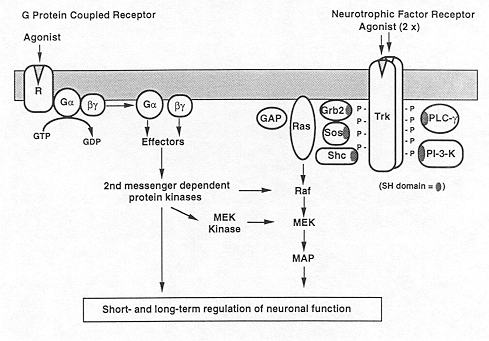
Schematic illustration of the mechanisms by which G-protein coupled receptors and receptor-associated protein tyrosine kinases function in the brain. G-protein coupled receptors and receptor-associated protein tyrosine kinases employ distinct mechanisms for activation of intracellular signal transduction pathways. Activation of G-protein coupled receptors (R) leads to association of the receptor with a heterotrimeric G-protein comprised of single a, b, and g subunits. This leads to the binding of GTP to the a subunit and the displacement of GDP from the subunit. GTP binding induces the generation of free a subunit by causing the dissociation of the a subunit from its bg subunits and the receptor. Free a subunit bound to GTP, and free ba subunits, are functionally active and directly regulate a number of effector proteins, which, depending on the type of a and ba subunits and cell involved, can include ion channels, adenylyl cyclase, phospholipase C, and phosphodiesterases. GTPase activity intrinsic to the a subunit hydrolyzes GTP to GDP. This leads to the reassociation of the a and bg subunits, which, along with the dissociation of ligand from the receptor, leads to restoration of the basal state.
Nerve growth factor receptors (i.e., Trks), as well as other growth factor receptors, stimulate protein tyrosine kinase activity intrinsic to the receptor. Binding of two molecules and dimerization of Trk receptors is necessary for receptor activation. This leads to phosphorylation of the receptor itself and adaptor proteins with Src homology (SH) domains, such as Shc. The SH proteins, or phosphorylated receptor in some cases, then associates with Grb2. Grb2 then complexes with Sos (and related Ras effector proteins) via SH domains to promote GTP binding to Ras. The function of Ras is also negatively regulated by GAP (GTPase activating protein), which stimulates Ras GTPase activity and the hydrolysis of GTP to GDP. Ras, bound to GTP, is functionally active and directly stimulates Raf by an unknown mechanism. Raf, a protein serine/threonine kinase, phosphorylates and activates MEK (Mitogen and Extracellular-regulated Kinase), which then activates MAP kinase (Microtubule Associated Protein kinase; also referred to as ERK, Extracellular signal-Regulated Kinase) by phosphorylating it on threonine and tyrosine residues. Raf and possibly other MEK kinases can also be activated by second messenger-dependent protein kinases. This provides a pathway by which G-protein coupled receptors can influence this major growth factor-Ras cascade.